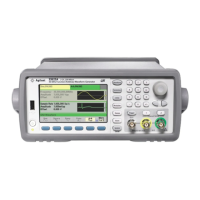AC Amplitude (high-impedance) Verification
AC Amplitude (high-impedance) Verification
Checks AC amplitude output accuracy at 1 kHz frequency using each attenuator.
1. Set the DMM to measure Vrms. Connect the DMM to the channel output as shown below.
2. Set the instrument to each output in the table below and measure the output voltage with the DMM. Be sure the
output impedance is set to High–Z and the output is enabled.
Use Waveform Generator Measurement
Output Setup Function Frequency Amplitude Nominal Error*
Q High Z** Sine 1.000 kHz 400.0 mVrms 0.400 Vrms ±0.004707 Vrms
Q High Z Sine 1.000 kHz 400.0 mVrms 0.400 Vrms ±0.004707 Vrms
Q High Z Sine 1.000 kHz 1.00 Vrms 1.00 Vrms ±0.010707 Vrms
Q High Z Sine 1.000 kHz 2.500 Vrms 2.5 Vrms ±0.025707 Vrms
Q High Z Sine 1.000 kHz 7.000 Vrms 7.0000 Vrms ±0.070707 Vrms
* Based upon 1% of setting ±1 mVpp (50 Ω); converted to Vrms for High–Z.
** Use the following sequence to set this output:
a. Set amplitude to 400.0 mVrms
b. Set DC Offset to 1.0 VDC
c. Set Auto-Range to OFF
d. Set DC Offset Voltage to 0.0 VDC
e. After the measurement, set Auto-Range ON for remaining measurements.
3. Compare the measured value to the test limits shown in the table.
4. Two-channel instruments only: connect DMM to channel 2 output and repeat steps 2 and 3.
Agilent 33500 Series Operating and Service Guide 379

